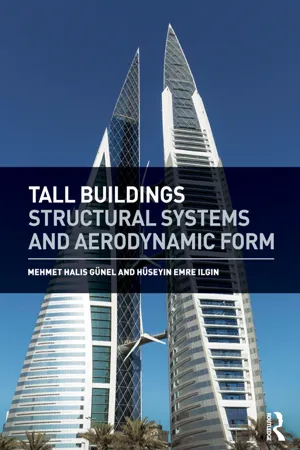
- 214 pages
- English
- ePUB (mobile friendly)
- Available on iOS & Android
About this book
The structural challenges of building 800 metres into the sky are substantial, and include several factors which do not affect low-rise construction. This book focusses on these areas specifically to provide the architectural and structural knowledge which must be taken into account in order to design tall buildings successfully. In presenting examples of steel, reinforced concrete, and composite structural systems for such buildings, it is shown that wind load has a very important effect on the architectural and structural design. The aerodynamic approach to tall buildings is considered in this context, as is earthquake induced lateral loading.
Case studies of some of the world's most iconic buildings, illustrated with full colour photographs, structural plans and axonometrics, will bring to life the design challenges which they presented to architects and structural engineers. The Empire State Building, the Burj Khalifa, Taipei 101 and the HSB Turning Torso are just a few examples of the buildings whose real-life specifications are used to explain and illustrate core design principles, and their subsequent effect on the finished structure.
Frequently asked questions
- Essential is ideal for learners and professionals who enjoy exploring a wide range of subjects. Access the Essential Library with 800,000+ trusted titles and best-sellers across business, personal growth, and the humanities. Includes unlimited reading time and Standard Read Aloud voice.
- Complete: Perfect for advanced learners and researchers needing full, unrestricted access. Unlock 1.4M+ books across hundreds of subjects, including academic and specialized titles. The Complete Plan also includes advanced features like Premium Read Aloud and Research Assistant.
Please note we cannot support devices running on iOS 13 and Android 7 or earlier. Learn more about using the app.
Information
Table of contents
- Cover
- Half Title
- Title Page
- Copyright Page
- Table of Contents
- Acknowledgements
- Illustration credits
- Preface
- Introduction
- 1 Tall buildings
- 2 Lateral loads affecting tall buildings
- 3 The structural systems of tall buildings
- 4 Tall building case studies
- 5 The effect of wind on tall buildings
- 6 Design approaches against wind excitation
- Appendix: Examples of tall buildings and their structural systems
- Bibliography
- Index